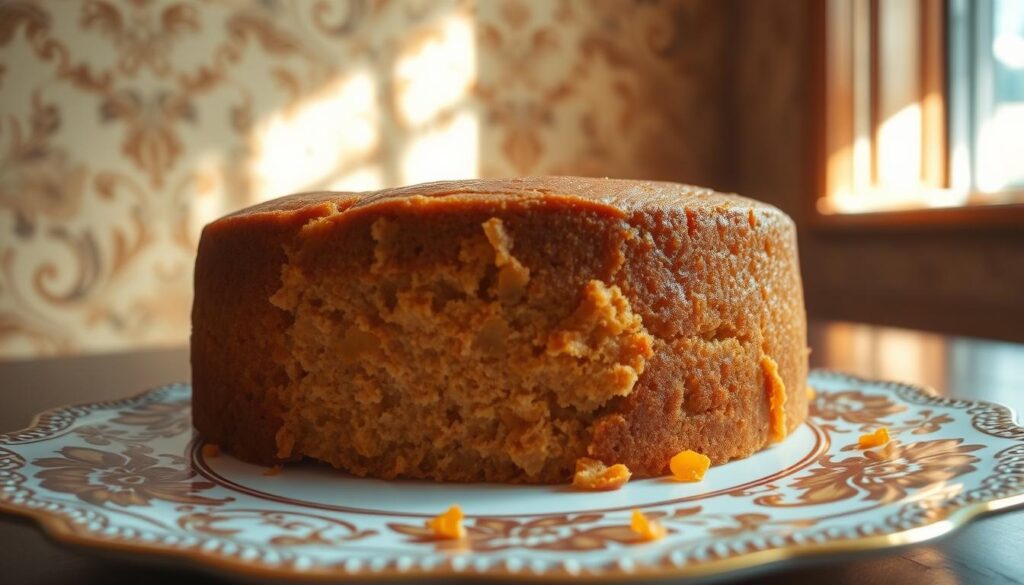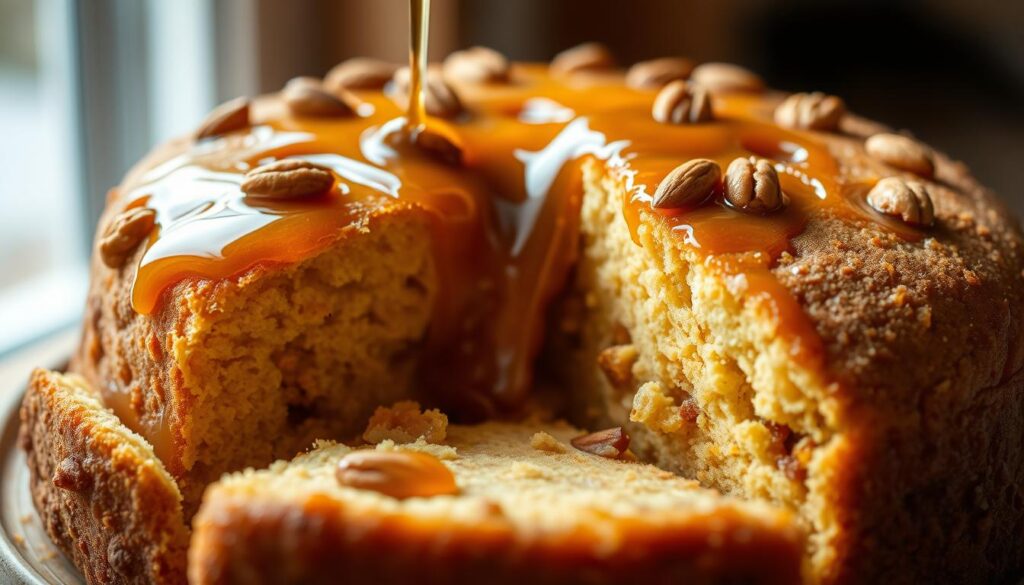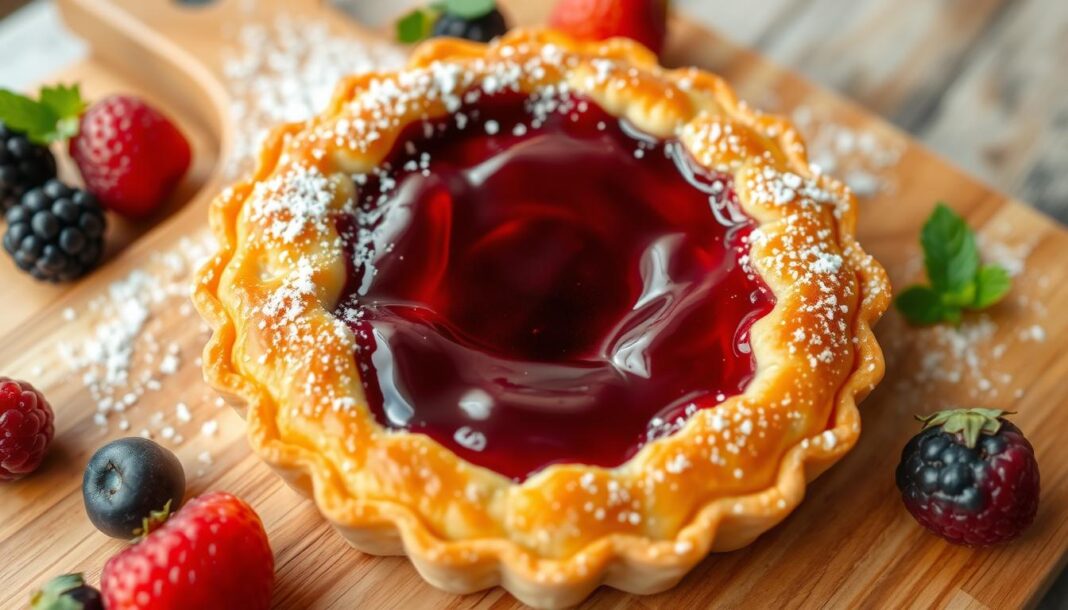For centuries, honeycakes have captivated bakers and food enthusiasts across multiple cultures. These traditional sweets have been featured in literature, such as in The Hobbit, where Beorn gives a stack of them to the dwarves, Gandalf, and Bilbo on their journey. The cakes, soaked in honey, were known to keep for a “good long time” and had a distinctive flavor profile.
We will explore the historical significance of these cakes and delve into the science behind their unique texture and flavor. By understanding traditional baking methods, we can recreate these historical treats and appreciate their cultural importance.
Key Takeaways
- Discover the historical significance of honeycakes across cultures.
- Learn about the science behind the distinctive texture and flavor of honeycakes.
- Understand traditional baking methods for recreating historical treats.
- Explore the cultural importance of honeycakes in literature and traditions.
- Gain practical advice for baking authentic honeycakes at home.
The Rich History of Honeycakes Through the Ages
The history of honeycakes spans centuries, reflecting a rich tapestry of cultural and culinary traditions. Honey has been a prized ingredient across various cultures, and its incorporation into cakes has led to the development of diverse and intricate desserts.

Ancient Origins and Cultural Significance
Honeycakes originated in ancient times, with evidence suggesting their presence in early Mediterranean and Middle Eastern cultures. These early cakes were not only significant for their taste but also held cultural and symbolic meanings. The use of honey in baking was a testament to the resourcefulness and creativity of ancient bakers who valued this viscous, sweet liquid for its preservative qualities and flavor.
In many cultures, honeycakes were associated with rituals and ceremonies, further emphasizing their importance beyond the culinary realm. The cultural significance of honeycakes is a reflection of the reverence with which honey was regarded, often being considered a gift from the gods.
How Honeycakes Evolved Across Different Cultures
As cultures interacted and culinary practices were exchanged, honeycakes evolved, incorporating local ingredients and techniques. The Russian Medovik Torte, for instance, is a layered honey cake that showcases the evolution of honeycake recipes over time, featuring thin layers of cake and a rich cream filling. Similarly, other regions developed their unique variations, such as the spiced honey-based baked goods of Northern Europe, which became integral to winter celebrations.
The evolution of honeycakes demonstrates the dynamic nature of culinary traditions, adapting to local tastes and ingredients while maintaining a connection to their historical roots. By examining these variations, we gain insight into the spread and transformation of basic culinary concepts across geographical boundaries.
Understanding Traditional Honeycakes
The traditional honeycake, with its rich history and cultural significance, continues to captivate bakers and food enthusiasts alike. To truly appreciate this dessert, we must delve into its key characteristics and the pivotal role honey plays in its creation.
Key Characteristics of Authentic Honeycakes
Authentic honeycakes are known for their distinctiveness, primarily due to the use of honey as the sole sweetener. This traditional baking method results in a cake that is not only dense but also remarkably moist. The hygroscopic nature of honey contributes to the cake’s moisture retention, allowing it to stay fresh longer than cakes made with refined sugar.
The complex composition of honey, which includes various sugars, enzymes, amino acids, and aromatic compounds, creates a depth of flavor that is hard to achieve with other sweeteners. Different varieties of honey impart unique flavor profiles to the cake, with darker honeys providing robust flavors and lighter varieties offering more delicate notes.
The Role of Honey in Traditional Baking
In traditional baking, honey is more than just a sweetener; it’s a crucial ingredient that influences the cake’s moisture content, shelf life, and the chemical reactions during the baking process. The technique of caramelizing or “burning” honey adds a concentrated honey flavor and introduces toffee notes, bitterness, and acidity, enhancing the overall flavor profile.
Understanding the scientific properties of honey in baking enables modern bakers to make informed decisions about honey selection and preparation techniques. This knowledge allows for the recreation of traditional cake recipes with precision, ensuring that the final product is both authentic and delicious.

Essential Ingredients for Perfect Honeycakes
Creating the perfect honeycake requires a deep understanding of its essential ingredients. The quality and type of ingredients used can significantly impact the final product’s flavor, texture, and overall character.
Selecting the Right Type of Honey
The type of honey used in honeycakes can vary, but it’s crucial to choose a high-quality honey that complements the other ingredients. Different varieties of honey, such as clover or manuka, offer unique flavor profiles that can enhance the honeycake’s overall taste.
Other Critical Ingredients and Their Purpose
Besides honey, other critical ingredients include sugar, butter, flour, and eggs. Sugar adds sweetness and tenderness, while butter contributes to the cake’s moisture and flavor. The type of flour used affects the texture, with wheat flour being traditional but other types like almond flour offering alternatives for specific dietary needs.
| Ingredient | Purpose |
|---|---|
| Honey | Primary sweetener and flavor component |
| Sugar | Adds sweetness and tenderness |
| Butter | Contributes to moisture and flavor |
| Flour | Affects texture and structure |
Traditional vs. Modern Ingredient Substitutions
Traditional honeycake recipes relied on a straightforward list of ingredients, but modern adaptations have introduced various substitutions to cater to different tastes and dietary requirements. For instance, using all honey instead of a combination of honey and sugar is a common substitution, as is replacing butter with oil or using gluten-free flours for those with dietary restrictions. These substitutions can alter the baking process and the final product’s characteristics.
When making substitutions, it’s essential to consider the potential impacts on the final product and adjust other ingredients accordingly to maintain the essence of the traditional honeycake.
Classic Honeycakes Preparation Methods
The preparation of honeycakes is an intricate process that involves multiple techniques, including the twice-baked method and the burnt honey method. Mastering these classic methods is essential for achieving the characteristic texture and flavor of traditional honeycakes.
The Twice-Baked Technique
The twice-baked technique is a traditional method used to create honeycakes with a distinctive texture. This involves baking the cake twice, with a resting period in between, to achieve a dry exterior and a moist interior. To implement this technique, bakers typically prepare thebatteraccording to a specific recipe, pour it into a preparedbowlor mold, and then bake it until it’s partially cooked. After the first bake, the cake is removed from the oven,set asideto cool, and then baked again until it reaches the desired level of dryness.
The Burnt Honey Method
The burnt honey method involves caramelizing honey to create a rich, deep flavor. This is achieved by heating honey until it darkens and develops a distinct aroma. To incorporate burnt honey into honeycakes, bakers combine it with other ingredients, such as milk, to create amixturethat is then added to the dry ingredients. Using awhisk, the ingredients are mixed until just combined, taking care not to overmix thebatter.
Proper Mixing and Handling of Honeycake Batter
Proper mixing and handling of honeycakebatteris crucial for achieving the right texture. In a medium-sizedbowl, sift together flour, cornstarch,baking powder, baking soda, salt, and ground cinnamon. The dry ingredients are then combined with wet ingredients, including melted butter, oil, vanilla, and eggs, in a largebowl. The honey and milkmixtureis heated until hot and then added to the other ingredients. The entirebatteris mixed until smooth and thenset asidebefore being poured into a baking dish.
By understanding and applying these classic preparation methods, bakers can create honeycakes that are both authentic and delicious. Whether using the twice-baked technique or the burnt honey method, attention to detail and proper handling of thebatterare key to achieving the desired texture and flavor.
Three Traditional Honeycake Recipes to Master
For those looking to delve into the world of honeycakes, we present three traditional recipes that showcase the versatility and richness of this ancient dessert. These recipes not only highlight the importance of honey in baking but also demonstrate various techniques and textures that have been cherished across cultures.
Beorn’s Twice-Baked Honeycakes
Beorn’s Twice-Baked Honeycakes are a classic recipe that embodies the traditional method of twice-baking, which enhances the flavor and texture of the honeycakes. To start, preheat your oven to 350°F (175°C). Mix 2 cups of honey with other ingredients and pour the batter onto a baking sheet lined with parchment paper.
The first bake is at a higher temperature to set the shape, followed by a second bake at a lower temperature to dry out the cakes. This method results in a cake that is both moist and durable. The twice-baked technique is crucial for achieving the signature texture.
| Ingredient | Quantity |
|---|---|
| Honey | 2 cups |
| Flour | 3 cups |
| Eggs | 4 |
Pure Honey Cake with No Added Sugar
The Pure Honey Cake is a delightful recipe that relies solely on the natural sweetness of honey. This cake is perfect for those looking to reduce their sugar intake without compromising on taste. The key to this recipe is using high-quality, pure honey that provides both sweetness and moisture to the cake.
To prepare, mix 1 cup of pure honey with other ingredients and pour into a greased cake pan. Bake at 325°F (165°C) for about 45 minutes or until a toothpick comes out clean. The result is a moist and flavorful cake with a rich honey flavor.
Russian Medovik Torte (Layered Honey Cake)
The Russian Medovik Torte, or Layered Honey Cake, is a majestic dessert featuring multiple thin layers of honey-infused cakes separated by a rich cream filling. This torte is a testament to the complexity and beauty of traditional honeycake recipes.
To make the cake layers, a honey-enriched dough is rolled thin and baked until caramelized. The cream filling is made by whipping cream with burnt honey and dulce de leche, creating a complex flavor profile. The torte requires a resting time of at least 24 hours to allow the flavors to meld and the layers to soften.
Tips for Honeycake Success and Serving Suggestions
As you master the art of baking honeycakes, don’t forget the importance of proper storage and presentation. To keep your honey cakes fresh, store them in an airtight container at room temperature.
Storage and Shelf Life
Honeycakes can be stored for several days when properly sealed. They can be served while still slightly warm or at room temperature, offering flexibility in serving.
Perfect Pairings and Presentation Ideas
When it comes to serving your cake, consider enhancing it with complementary flavors and visually appealing presentations. We suggest pairing your dessert with thoughtfully chosen accompaniments like cream or seasonal fruits.
For a simple yet elegant presentation, serve individual honeycakes on small plates with a light dusting of powdered sugar and a drizzle of warmed honey. Consider adding decorative elements like sliced almonds or “Bumblebee” decorations to give your cake a personal touch.
Traditional beverage pairings include black tea or mead (honey wine), which complement the honey flavor. Dairy accompaniments like whipped cream or vanilla ice cream provide a creamy contrast to the dense cake.


